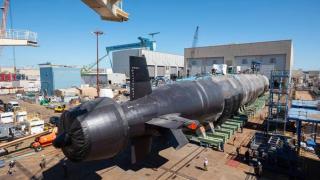The rationale and intent of AUKUS is sound. However, it will be costly and present ongoing opportunity costs and trade-offs, not only for defence but for broader national resources.
While the first two phases of AUKUS Pillar I – rotations of US and UK submarines in Australia in the 2020s followed by purchasing US nuclear-powered submarines in the 2030s – are by no means small endeavours, the third phase will be by far the largest component of the A$268 - $368 billion cost. Phase Three involves the Australia-UK co-design of a new ‘AUKUS class’ submarine and the domestic build of eight boats in Australia.
It is possible that future governments, in the face of other mounting financial pressures, may explore modifications to or other options for Phase Three. In that scenario, there could be opportunities to better structure the deal to procure submarines more cheaply and increase the economic and defence industry benefits for Australia.
The headline figures
AUKUS’ price tag of between $268 - $368 billion is the largest defence procurement in Australia’s history. No major defence capability comes cheaply, however, since 2016 the estimated costs for procuring a new submarine fleet have been much lower. In 2016 it was “>$50 billion” and in 2021 it was $77 billion or up to $171 billion, accounting for inflation. The new top-line figure of $368 billion caused surprise among many defence experts and close observers.
Given AUKUS’ 30-year timeframe, there is no easy way to draw a cost comparison for context. However, AUKUS is forecast to increase defence spending from 2.05 to 2.20 per cent of GDP. This constitutes 1/14 or seven per cent of the total defence budget, a significant portion.
AUKUS is forecast to increase defence spending from 2.05 to 2.20 per cent of GDP. This constitutes 1/14 or seven per cent of the total defence budget, a significant portion.
Two factors contribute to AUKUS’ ballooned price tag. Firstly, the cost is comprehensive. It includes purchasing between three and five US Virginia class submarines, designing and building eight AUKUS class submarines, upgrading naval infrastructure, investments in submarine production lines, workforce education and training, and sustainment. Secondly, beyond providing a new defence capability, AUKUS seeks to transform Australia’s defence industry. The government has touted the agreement as ‘the most transformative industrial endeavour in Australian history significance’, surpassing the creation of an Australian automotive manufacturing sector.
The huge leeway in the price tag – $100 billion – is also self-aware. It communicates that government simply cannot estimate with any accuracy how much AUKUS could cost out to the 2050s, across 10 terms of the Australian government. Like the US space race, AUKUS will cost a lot and we won’t know how much until the end.
Funding sources – within and outside Defence, borrowing and beyond
Although AUKUS’ expenses over the next three years of Forward Estimates have been described by the government as ‘cost-neutral’, there will be an immediate impact as money is ‘repurposed’ from within Defence.
Over the Forward Estimates Australia will spend $9 billion on AUKUS, comprised of $6 billion previously earmarked for submarines and $3 billion in ‘savings’ from the existing Defence portfolio. Prior to the ‘Optimal Pathway’ announcement on 14 March, the Defence Minister rejected concerns AUKUS would cannibalise funding from other parts of the Navy or Defence force overall. However, it is unlikely resources could come exclusively from outside the three services, such as from Defence Science and Technology or the civilian organisation itself, without having cascading or workforce impacts. Longer term, costs will start to ramp up with reporting AUKUS will cost between $26 - $34 billion over the next decade.
In addition to finding Defence savings, the government will likely re-assess the balance of national spending. Supporting AUKUS comes at a time when Australia, like other countries, has other major national expenses to service alongside rising inflation. Defence spending as well as health, the National Disability Insurance Scheme (NDIS), aged care, and debt servicing are currently among the nation’s top expenses.
|
Sector |
Current per cent of GDP |
|
Health |
4.46% |
|
Defence (inc. ASD costs |
1.98% |
|
NDIS |
1.44% |
|
Aged care |
1.10% |
Some resourcing necessities, like aged care, will continue to increase over time with Australia’s greying population. Rising domestic expenses will make the task of re-shuffling finances to support AUKUS more challenging, particularly for the most expensive Phase Three. The Labor government has committed to spending more on Australia’s defence, although, how defence ranks in comparison to other demands is unknown.
Australian governments have historically preferred to have a balanced budget but rising costs across national priorities might force them to seriously consider borrowing. While borrowing is more expensive now because of increased interest rates, increasing government debt is potentially more viable than it sounds. Government debt rose significantly over the COVID pandemic, in addition to the debt accumulated post the Global Financial Crisis. Yet, Australia’s current debt level – more than 38 per cent of GDP – is relatively modest and below average compared with other OECD nations. Plus, Australia’s debt levels are still below historical peaks, such as in 1919 (54.4 per cent GDP), 1930 (61 per cent GDP), and 1945 (125 per cent GDP) post the Second World War.
Another prospect would be for the government to raise taxes or cancel the promised stage three tax cuts. The stage three tax cuts have bipartisan support and would see changes to various tax brackets in July 2024, including greater standardisation around a 30 per cent rate. However, given how politically unpopular the former would be and the government’s repeated commitments to the latter, this is the least likely of possible options.
Defence industry and workforce benefits in context
Depending on whether all phases are realised, AUKUS offers short, medium, and long-term defence infrastructure, industry, and workforce benefits. However, the scale of these benefits should be seen in context, alongside the costs and other metrics. Although AUKUS is not primarily about job creation or spurring defence industry, there is a pathway that could deliver submarines more cheaply and more substantially fuel the Australian defence ecosystem.
From a national perspective, the creation of 20,000 jobs supported by AUKUS’ level of investment over three decades is modest. For instance, over the last 30 years, the Australian economy overall created more than six million new jobs.
Given AUKUS’ extended timeframe, the short-term and therefore highest likelihood deliverables are most relevant to assess. These include $8 billion to upgrade HMAS Stirling Navy base in Western Australia, creating around 3,000 jobs, and a further $2 billion to upgrade Osborne North shipyard in South Australia. Over the next four years, $6 billion will be invested in Australia’s industrial capacity and workforce. Australian personnel will embed with the US and UK navies and submarine industries, resulting in knowledge and skills transfer, and the government is supporting nuclear science and engineering education and training.
Upgrading infrastructure, more jobs, and a better skilled and educated workforce are all positive developments, with wider flow-on economic benefits. Longer term, AUKUS’ costs will begin to ramp up with Phase Two – purchasing US Virginia class submarines – and then increase significantly in Phase Three with the Australia-UK co-design of a new AUKUS class submarine, built in the UK and Australia.
AUKUS’ Phase Three would be the most expensive, constituting $100 billion or more of the total cost. Although Phase Three would be the primary catalyst for creating up to 20,000 new Australian jobs, this figure should also be considered in context. On one hand, that is a huge increase: Australia currently has 15,000 people employed in its national shipbuilding enterprise, so AUKUS could more than double it. But, from a national perspective, the creation of 20,000 jobs supported by AUKUS’ level of investment over three decades is modest. For instance, over the last 30 years, the Australian economy overall created more than six million new jobs.
Rather than continuing with Phase Three, a future Australian Government may consider simply purchasing UK Astute class submarines off-the-shelf, preferring them over the US Virginia class which has a higher crewing requirement. Australia could invest the savings into AUKUS’ Pillar II on advanced defence capabilities.
AUKUS’ Pillar II economic potential
The AUKUS Optimal Pathway announcement related only to Pillar I, not Pillar II. The prospects for Australian defence industry growth, innovation, and job creation are substantially elevated by AUKUS Pillar II. Pillar II includes hypersonic, quantum, AI, autonomy, undersea warfare, and cyber. Investment into new technologies such as these is the reason the United States has the most advanced defence capabilities in the world.
An investment of $100 billion into Australia’s defence technology companies could be transformative.
Investing in Australia’s defence science and technology (S&T) industry could lead to breakthroughs in dual, civilian-miliary use technologies, opening up broader commercialisation and export opportunities. For this reason, Pillar II stands to reinforce the entire Australian defence ecosystem, encompassing S&T, research and development, manufacturing, small and medium enterprises, and industrial base. Understandably, the political pressures to support Australia’s shipbuilding industry are intense. But the size of Australia’s shipbuilding industry pales in comparison with the industries and workforce associated with Pillar II.
An investment of $100 billion into Australia’s defence technology companies could be transformative.
Minister for Defence Industry, Pat Conroy, has previously expressed the need to deliver capability to the war fighter as soon as possible while maximising the industry benefits – although with a focus on the former. If this remains the goal over time, Australian governments of the 2040s and 2050s may reassess the need to create a new submarine type and build indigenously if they can receive UK Astute class submarines cheaper and faster and invest more into Pillar II’s game-changing technologies.
AUKUS’ price tag came as a shock, and the timing is challenging, with other national expenses rising. AUKUS’ actual cost, however, will not be known until much farther down the track. Along the way, the government will need to consider all funding sources, domestic and international. Importantly, it should not forget the potential defence capability discoveries possible in future years under AUKUS’ lower profile, Pillar II.






